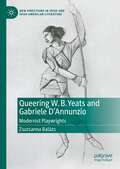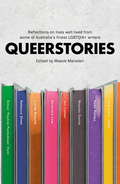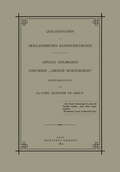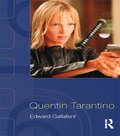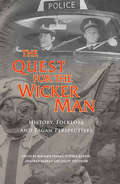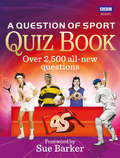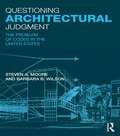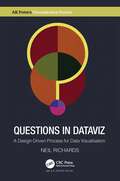- Table View
- List View
Queering the Subversive Stitch: Men and the Culture of Needlework
by Joseph McBrinnThe history of men's needlework has long been considered a taboo subject. This is the first book ever published to document and critically interrogate a range of needlework made by men. It reveals that since medieval times men have threaded their own needles, stitched and knitted, woven lace, handmade clothes, as well as other kinds of textiles, and generally delighted in the pleasures and possibilities offered by all sorts of needlework. Only since the dawn of the modern age, in the eighteenth and the nineteenth centuries, did needlework become closely aligned with new ideologies of the feminine. Since then men's needlework has been read not just as feminising but as queer.In this groundbreaking study Joseph McBrinn argues that needlework by male artists as well as anonymous tailors, sailors, soldiers, convalescents, paupers, prisoners, hobbyists and a multitude of other men and boys deserves to be looked at again. Drawing on a wealth of examples of men's needlework, as well as visual representations of the male needleworker, in museum collections, from artist's papers and archives, in forgotten magazines and specialist publications, popular novels and children's literature, and even in the history of photography, film and television, he surveys and analyses many of the instances in which “needlemen” have contested, resisted and subverted the constrictive ideals of modern masculinity.This audacious, original, carefully researched and often amusing study, demonstrates the significance of needlework by men in understanding their feelings, agency, identity and history.
Queering W. B. Yeats and Gabriele D’Annunzio: Modernist Playwrights (New Directions in Irish and Irish American Literature)
by Zsuzsanna BalázsQueering W. B. Yeats and Gabriele D’Annunzio: Modernist Playwrights challenges the general resistance in scholarship and queer studies to approach Yeats and D’Annunzio through a queer lens because of their controversial affiliations with fascism and elitism, their heterosexuality and their venerated canonical status. This book provides the first fully theorised queer and comparative reading of Yeats’s and D’Annunzio’s drama. It offers the novel contention that due to their increasing involvement in queer and feminist subcultures, their plays feature feelings that are associated with queer historiography and generate ideas that began to be theorised by queer studies more than half a century after the composition of the plays. Moreover, it uncovers an alert, subversive and often coded social commentary in eight key dramatic texts by each playwright and at the same time highlights the thus far neglected commonalities between the plays and the queer historical as well as cultural contexts of these two prominent modernists.
Queerstories: Reflections on lives well lived from some of Australia's finest LGBTQIA+ writers
by Maeve MarsdenThere's more to being queer than coming out and getting married. This exciting and contemporary collection contains stories that are as diverse as the LGBTQIA+ community from which they're drawn. From hilarious anecdotes of an awkward adolescence, to heartwarming stories of family acceptance and self-discovery, the LGBTQIA+ community has been sharing stories for centuries, creating their own histories, disrupting and reinventing conventional ideas about narrative, family, love and community.Curated from the hugely popular Queerstories storytelling event this important collection features stories from Benjamin Law, Jen Cloher, Nayuka Gorrie, Peter Polites, Candy Royalle, Rebecca Shaw, Simon 'Pauline Pantsdown' Hunt, Steven Lindsay Ross, Amy Coopes, Paul van Reyk, Mama Alto, Liz Duck-Chong, Maxine Kauter, David Cunningham, Peter Taggart, Ben McLeay, Jax Jacki Brown, Ginger Valentine, Candy Bowers, Simon Copland, Kelly Azizi, Nic Holas, Quinn Eades, Vicki Melson, Tim Bishop and Maeve Marsden.
Quellenstudien zur Holländischen Kunstgeschichte: Arnold Houbraken und Seine „Groote Schouburgh“ (Quellenstudien zur Holländischen Kunstgeschichte #5)
by Arnold HoubrakenQuentin Blake: An Artist at Work
by Ghislaine KenyonQuentin Blake is one of the foremost illustrators of the twentieth century. Perhaps best known for his collaboration with Roald Dahl on books such as The Giraffe and the Pelly and Me, The Twits and Matilda, he is cherished by young and old alike, throughout the world.Yet his work has not attained 'fine art' status. Should it be considered so? How does Blake's background in education inform his work? And what is the interrelation between the work he makes and the life that he leads? Distinguished curator Ghislaine Kenyon has spent a great deal of time with Blake during the last decade and a half and in Quentin Blake In the Theatre of the Imagination she provides a profound insight into an extraordinary man and a truly remarkable body of work.Kenyon has known Quentin Blake since 1998, and worked with him on staging a jointly curated exhibition 'Tell Me A Picture' in the year of Blake's tenure as Children's Laureate (1999-2000). She followed Blake during the years in which he continued to work 'off the page' producing work for hospitals in Angers and Paris and staging major exhibitions around the world, collaborating with him both in an administrative and curatorial capacity. But what Kenyon has observed, during a number of years of working alongside him, and sharing a friendship, is that Blake's work is necessarily intertwined with his life. His life informs his wonderful illustrations and his artwork in turn informs his life - a life which is extremely private, mysterious and full of complexities and ambiguities.Kenyon and Blake share a background in teaching, and this interest informs Blake's connection to what educationists call 'learning and teaching' but which could also be termed simply education. A shared enthusiasm for education brought Kenyon and Blake together and informs the projects both the artist and curator now work on, aiming to reach children and adults in new ways and provide new experiences.With exceptional insight into Blake's oeuvre and his life, Ghislaine Kenyon has produced not merely a biography, but a critical view of the artist's work. Quentin Blake: In the Theatre of the Imagination is a fitting tribute to Quentin Blake's journey and his great legacy - the delightful illustrations to over 300 books, several written by him, paintings, prints and sculptures - and the contribution he has made to art education and the lives of so many different people.
Quentin Blake: An Artist at Work
by Ghislaine KenyonQuentin Blake is one of the foremost illustrators of the twentieth century. Perhaps best known for his collaboration with Roald Dahl on books such as The Giraffe and the Pelly and Me, The Twits and Matilda, he is cherished by young and old alike, throughout the world.Yet his work has not attained 'fine art' status. Should it be considered so? How does Blake's background in education inform his work? And what is the interrelation between the work he makes and the life that he leads? Distinguished curator Ghislaine Kenyon has spent a great deal of time with Blake during the last decade and a half and in Quentin Blake In the Theatre of the Imagination she provides a profound insight into an extraordinary man and a truly remarkable body of work.Kenyon has known Quentin Blake since 1998, and worked with him on staging a jointly curated exhibition 'Tell Me A Picture' in the year of Blake's tenure as Children's Laureate (1999-2000). She followed Blake during the years in which he continued to work 'off the page' producing work for hospitals in Angers and Paris and staging major exhibitions around the world, collaborating with him both in an administrative and curatorial capacity. But what Kenyon has observed, during a number of years of working alongside him, and sharing a friendship, is that Blake's work is necessarily intertwined with his life. His life informs his wonderful illustrations and his artwork in turn informs his life - a life which is extremely private, mysterious and full of complexities and ambiguities.Kenyon and Blake share a background in teaching, and this interest informs Blake's connection to what educationists call 'learning and teaching' but which could also be termed simply education. A shared enthusiasm for education brought Kenyon and Blake together and informs the projects both the artist and curator now work on, aiming to reach children and adults in new ways and provide new experiences.With exceptional insight into Blake's oeuvre and his life, Ghislaine Kenyon has produced not merely a biography, but a critical view of the artist's work. Quentin Blake: In the Theatre of the Imagination is a fitting tribute to Quentin Blake's journey and his great legacy - the delightful illustrations to over 300 books, several written by him, paintings, prints and sculptures - and the contribution he has made to art education and the lives of so many different people.
Quentin Tarantino
by Edward GallafentQuentin Tarantino is one of the best-known living American filmmakers in the world, and the story of his career has been the subject of a number of books and articles. But what do his films mean? In this new study, Edward Gallafent does not look at Tarantino’s story but at the films themselves. He asks to what extent Tarantino can be seen as a specifically American filmmaker, with the kinds of preoccupations and interests that have formed part of Hollywood’s traditions, and also how he explores the expressive possibilities of current cinema. The book concentrates on the main feature films of Tarantino’s career so far: Reservoir Dogs, Pulp Fiction, Jackie Brown, and the two volumes of Kill Bill. Apart from Kill Bill the films are not treated individually, but in terms of some of the subjects that connect them together, such as success and tradition, their notorious deployment of violence, and Tarantino’s approach to story-telling: his interest in presenting events out of chronological order. The book also covers adaptations of Tarantino’s work, looking at the screenplays of True Romance and Natural Born Killers as well as the films made from them, and compares Tarantino’s approach to adapting Elmore Leonard with that of another important American filmmaker, Paul Schrader. The aim of the book is to explore these topics and to take the reader back to what the American critic Robert Warshow called the ‘actual, immediate experience of seeing and responding to the movies’. It is designed to appeal both to those who were excited by the films on first seeing them in the cinema and to those taking the opportunity of reconsidering them on the screen or on DVD.
Quentin Tarantino
by Edward GallafentQuentin Tarantino is one of the best-known living American filmmakers in the world, and the story of his career has been the subject of a number of books and articles. But what do his films mean? In this new study, Edward Gallafent does not look at Tarantino’s story but at the films themselves. He asks to what extent Tarantino can be seen as a specifically American filmmaker, with the kinds of preoccupations and interests that have formed part of Hollywood’s traditions, and also how he explores the expressive possibilities of current cinema. The book concentrates on the main feature films of Tarantino’s career so far: Reservoir Dogs, Pulp Fiction, Jackie Brown, and the two volumes of Kill Bill. Apart from Kill Bill the films are not treated individually, but in terms of some of the subjects that connect them together, such as success and tradition, their notorious deployment of violence, and Tarantino’s approach to story-telling: his interest in presenting events out of chronological order. The book also covers adaptations of Tarantino’s work, looking at the screenplays of True Romance and Natural Born Killers as well as the films made from them, and compares Tarantino’s approach to adapting Elmore Leonard with that of another important American filmmaker, Paul Schrader. The aim of the book is to explore these topics and to take the reader back to what the American critic Robert Warshow called the ‘actual, immediate experience of seeing and responding to the movies’. It is designed to appeal both to those who were excited by the films on first seeing them in the cinema and to those taking the opportunity of reconsidering them on the screen or on DVD.
Quentin Tarantino and Film Theory: Aesthetics and Dialectics in Late Postmodernity
by Federico PagelloThis book examines a set of theoretical perspectives that critically engage with the notion of postmodernism, investigating whether this concept is still useful to approach contemporary cinema. This question is explored through a discussion of the films written and directed by Quentin Tarantino, largely regarded as the epitome of postmodern cinema and considered here as theoretical contributions in their own right. Each chapter first presents key ideas proposed by a specific theorist and then puts them in conversation with Tarantino’s films. Jacques Rancière’s theory of art is used to reject postmodernism’s claims about the ‘death’ of the aesthetic image in contemporary cinema. Fredric Jameson’s and Slavoj Žižek’s dialectical thinking is mobilized to challenge simplistic, ideological readings of postmodern cinema in general, and Tarantino’s films in particular. Finally, the direct influence of Carol Clover’s psychoanalytical approach to the horror genre on Tarantino’s work is discussed to prove the director’s specific contribution to a theoretical understanding of contemporary film aesthetics.
Quentin Tarantino's Django Unchained: The Continuation of Metacinema
by Oliver C. SpeckDjango Unchained is certainly Quentin Tarantino's most commercially-successful film and is arguably also his most controversial. Fellow director Spike Lee has denounced the representation of race and slavery in the film, while many African American writers have defended the white auteur. The use of extremely graphic violence in the film, even by Tarantino's standards, at a time when gun control is being hotly debated, has sparked further controversy and has led to angry outbursts by the director himself. Moreover, Django Unchained has become a popular culture phenomenon, with t-shirts, highly contentious action figures, posters, and strong DVD/BluRay sales. The topic (slavery and revenge), the setting (a few years before the Civil War), the intentionally provocative generic roots (Spaghetti Western and Blaxploitation) and the many intertexts and references (to German and French culture) demand a thorough examination. Befitting such a complex film, the essays collected here represent a diverse group of scholars who examine Django Unchained from many perspectives.
Quentin Tarantino's Django Unchained: The Continuation of Metacinema
by Oliver C. SpeckDjango Unchained is certainly Quentin Tarantino's most commercially-successful film and is arguably also his most controversial. Fellow director Spike Lee has denounced the representation of race and slavery in the film, while many African American writers have defended the white auteur. The use of extremely graphic violence in the film, even by Tarantino's standards, at a time when gun control is being hotly debated, has sparked further controversy and has led to angry outbursts by the director himself. Moreover, Django Unchained has become a popular culture phenomenon, with t-shirts, highly contentious action figures, posters, and strong DVD/BluRay sales. The topic (slavery and revenge), the setting (a few years before the Civil War), the intentionally provocative generic roots (Spaghetti Western and Blaxploitation) and the many intertexts and references (to German and French culture) demand a thorough examination. Befitting such a complex film, the essays collected here represent a diverse group of scholars who examine Django Unchained from many perspectives.
Quentin Tarantino's Inglourious Basterds: A Manipulation of Metacinema
by Robert Von DassanowskyThis provocative and unique anthology analyzes Quentin Tarantino's controversial Inglourious Basterds in the contexts of cinema, cultural, gender, and historical studies. The film and its ideology is dissected by a range of scholars and writers who take on the director's manipulation of metacinema, Nazisploitation, ethnic stereotyping, gender roles, allohistoricism, geopolitics, philosophy, language, and memory. In this collection, the eroticism of the club-swinging and avenging "Bear Jew," the dashed heroism of the "role-playing" French and German females, the patriotic fools and pawns, the amoral yokel, Lieutenant Aldo Raine, and the cosmopolitan, but psychopathic Colonel Landa, are understood for their true functions in what has become an iconoclastic pop-culture phenomenon and one of the classics of early twenty-first century American cinema. Additionally, the book examines the use of "foreign" languages (subverting English and image), the allegory of Austria's identity in the war, and the particularly French and German cinematic influences, such as R. W. Fassbinder's realignment of the German woman's film and the iconic image of the German film star in Inglourious Basterds.
Quentin Tarantino's Inglourious Basterds: A Manipulation of Metacinema
by Robert Von DassanowskyThis provocative and unique anthology analyzes Quentin Tarantino's controversial Inglourious Basterds in the contexts of cinema, cultural, gender, and historical studies. The film and its ideology is dissected by a range of scholars and writers who take on the director's manipulation of metacinema, Nazisploitation, ethnic stereotyping, gender roles, allohistoricism, geopolitics, philosophy, language, and memory. In this collection, the eroticism of the club-swinging and avenging "Bear Jew," the dashed heroism of the "role-playing" French and German females, the patriotic fools and pawns, the amoral yokel, Lieutenant Aldo Raine, and the cosmopolitan, but psychopathic Colonel Landa, are understood for their true functions in what has become an iconoclastic pop-culture phenomenon and one of the classics of early twenty-first century American cinema. Additionally, the book examines the use of "foreign" languages (subverting English and image), the allegory of Austria's identity in the war, and the particularly French and German cinematic influences, such as R. W. Fassbinder's realignment of the German woman's film and the iconic image of the German film star in Inglourious Basterds.
The Quest for Charles Rennie Mackintosh (The\quest For Ser. #0)
by John CairneyLike Charles Rennie Mackintosh, John Cairney began his career at the age of 15 at the Glasgow School of Art. He tells of the working life of Charles Rennie Mackintosh as well as the beautiful love story which tragically ended with Mackintosh's sudden death at the age of 60. His wife and co-artist, Margaret Macdonald died three years later.
The Quest for God in the Work of Borges (Continuum Literary Studies)
by Annette U. FlynnThis book argues that the quest for God, though largely unheeded by the critical canon, was a major and enduring preoccupation for Borges. This is shown through careful analysis both of his essays, with their emphasis on his philosophical-theological explorations, and of the narrative articulations which are his stories. It is in the poetry of his middle and closing years, however, that Borges' search is most manifest, as it is no longer obscured. Spanning different periods of his life, and different literary genres, Borges' work attests to a maturing and evolving quest. The book reveals Borges' engagement as an active and evolving process and its chronological structure allows the reader to trace his thought over time. Flynn shows that the spiritual component in Borges' writing drives key texts from the 1920s to the 1980s. Offering an interpretation that unlocks a fuller significance of his work, she shows how Borges' reflections on time and identity are symptomatic of a deeper, spiritual searching which can only be answered by a Divine Absolute.
The Quest for God in the Work of Borges (Continuum Literary Studies #203)
by Annette U. FlynnThis book argues that the quest for God, though largely unheeded by the critical canon, was a major and enduring preoccupation for Borges. This is shown through careful analysis both of his essays, with their emphasis on his philosophical-theological explorations, and of the narrative articulations which are his stories. It is in the poetry of his middle and closing years, however, that Borges' search is most manifest, as it is no longer obscured. Spanning different periods of his life, and different literary genres, Borges' work attests to a maturing and evolving quest. The book reveals Borges' engagement as an active and evolving process and its chronological structure allows the reader to trace his thought over time. Flynn shows that the spiritual component in Borges' writing drives key texts from the 1920s to the 1980s. Offering an interpretation that unlocks a fuller significance of his work, she shows how Borges' reflections on time and identity are symptomatic of a deeper, spiritual searching which can only be answered by a Divine Absolute.
The Quest for Gold
by Andrew FeketeThe Quest for Gold is an edited version of writings by visionary Andrew Fekete – a painter, architect, poet and writer, who died in 1986 from an Aids-related illness. Andrew, flâneur, walked the city; he was a man whose writings, to adapt the words of Baudelaire, serve as a mirror as vast as the crowd itself. This anthology, collated by his brother Peter, comprises key works from Andrew Fekete’s opus, and deals with his development as an artist, his visions and his experiment in Jungian alchemy – the intentional creation of visionary experiences to manifest unconscious archetypes to consciousness. The title is taken from an autobiographical novella that Andrew wrote in 1982, with extracts from his diaries also provided. The culmination of the anthology is the poem Punishment for the Transgressors in which Andrew confronts his impending death, thereby illustrating the connection between art and life. The work, which is open to multiple interpretations, is witty and entertaining, dramatic and engaging, full of deep sentiment and self-reflection. We journey with Andrew in his Quest for Gold that occurs against the background of his sexuality and his membership of the gay community. We see into the mind of a man undertaking an experiment in the exploration of what Jung calls the contents of the collective unconscious in an attempt at self-healing and expansion of consciousness. You can find out more about Andrew Fekete at www.andrewfekete.net and see a retroscpective of his work at the Victoria Gallery and Museum, Liverpool until April 2017.
Quest for the Unity of Knowledge (Routledge Environmental Humanities)
by David LowenthalIs unity of knowledge possible? Is it desirable? Two rival visions clash. One seeks a single way of explaining everything known and knowable about ourselves and the universe. The other champions diverse modes of understanding served by disparate kinds of evidence. Contrary views pit science against the arts and humanities. Scientists generally laud and seek convergence. Artists and humanists deplore amalgamation as a threat to humane values. These opposing perspectives flamed into hostility in the 1950s "Two Cultures" clash. They culminate today in new efforts to conjoin insights into physical nature and human culture, and new fears lest such syntheses submerge what the arts and humanities most value. This book, stemming from David Lowenthal’s inaugural Stockholm Archipelago Lectures, explores the Two Cultures quarrel’s underlying ideologies. Lowenthal shows how ingrained bias toward unity or diversity shapes major issues in education, religion, genetics, race relations, heritage governance, and environmental policy. Aimed at a general academic audience, Quest for the Unity of Knowledge especially targets those in conservation, ecology, history of ideas, museology, and heritage studies.
Quest for the Unity of Knowledge (Routledge Environmental Humanities)
by David LowenthalIs unity of knowledge possible? Is it desirable? Two rival visions clash. One seeks a single way of explaining everything known and knowable about ourselves and the universe. The other champions diverse modes of understanding served by disparate kinds of evidence. Contrary views pit science against the arts and humanities. Scientists generally laud and seek convergence. Artists and humanists deplore amalgamation as a threat to humane values. These opposing perspectives flamed into hostility in the 1950s "Two Cultures" clash. They culminate today in new efforts to conjoin insights into physical nature and human culture, and new fears lest such syntheses submerge what the arts and humanities most value. This book, stemming from David Lowenthal’s inaugural Stockholm Archipelago Lectures, explores the Two Cultures quarrel’s underlying ideologies. Lowenthal shows how ingrained bias toward unity or diversity shapes major issues in education, religion, genetics, race relations, heritage governance, and environmental policy. Aimed at a general academic audience, Quest for the Unity of Knowledge especially targets those in conservation, ecology, history of ideas, museology, and heritage studies.
The Quest for the Wicker Man: History, Folklore and Pagan Perspectives (The\quest For Ser.)
by Benjamin Franks Stephen Harper Jonathan Murray Lesley StevensonOne of the greatest films ever to be made in Scotland, The Wicker Man immediately garnered a cult following on its release for its intense atmosphere and shocking denouement. This book explores the roots of this powerful, enduring film. With contributors including The Wicker Man director Robin Hardy, it is a thorough and informative read for all fans of this indispensable horror masterpiece.
A Question of Sport Quiz Book
by David Gymer David BallAfter more than four decades on the air, A Question of Sport is firmly established as the final word in sports trivia. Now, after countless arguments, sporting debates and lost hours spent directing the action from the sofa, you can finally test your own knowledge to see if you can succeed where so many sporting greats have failed.With over 3,500 brand new questions, A Question of Sport Quiz Book will challenge you to put your money where your mouth is and put your knowledge of the sports world to the ultimate test. Play on your own or in teams to answer questions covering all eras of football, golf, cricket, motor racing, boxing, rugby, darts, snooker, the Olympics and so much more.With questions from your favourite rounds from A Question of Sport, here at last is your chance to take on the captain's challenge, or go head-to-head on the quick-fire buzzer round. What will be your score when the final whistle blows?
Questioning Architectural Judgment: The Problem of Codes in the United States
by Steven A. Moore Barbara B. WilsonThe book shines light on the problem of judgment, particularly in the realm of architectural "technics" and the codes that regulate it. The struggle to define "sustainability," and thus judge architecture through such lenses, is but one dimension of the contemporary problem of judgment. By providing the reader with an inherently interdisciplinary study of a particular discipline—architecture, it brings to the topic lenses that challenge the too frequently unexamined assumptions of the discipline. By situating architecture within a broader cultural field and using case studies to dissect the issues discussed, the book emphasizes that it is not simply a matter of designing better, more efficient, or more stringent codes to guide place-making, but a matter of reconstructing the boundaries of the systems to be coded. The authors are winners of the EDRA Place-Research Award 2014 for their work on the Green Alley Demonstration Project used in the book.
Questioning Architectural Judgment: The Problem of Codes in the United States
by Steven A. Moore Barbara B. WilsonThe book shines light on the problem of judgment, particularly in the realm of architectural "technics" and the codes that regulate it. The struggle to define "sustainability," and thus judge architecture through such lenses, is but one dimension of the contemporary problem of judgment. By providing the reader with an inherently interdisciplinary study of a particular discipline—architecture, it brings to the topic lenses that challenge the too frequently unexamined assumptions of the discipline. By situating architecture within a broader cultural field and using case studies to dissect the issues discussed, the book emphasizes that it is not simply a matter of designing better, more efficient, or more stringent codes to guide place-making, but a matter of reconstructing the boundaries of the systems to be coded. The authors are winners of the EDRA Place-Research Award 2014 for their work on the Green Alley Demonstration Project used in the book.
Questions in Dataviz: A Design-Driven Process for Data Visualisation (AK Peters Visualization Series)
by Neil RichardsThis book takes the reader through the process of learning and creating data visualisation, following a unique journey with questions every step of the way, ultimately discussing how and when to bend and break the "rules" to come up with creative, unique, and sometimes unconventional ideas. Each easy-to-follow chapter poses one key question and provides a selection of discussion points and relevant data visualisation examples throughout. Structured in three parts: Section I poses questions around some fundamental data visualisation principles, while Section II introduces more advanced questions, challenging perceived best practices and suggesting when rules are open to interpretation or there to be broken. The questions in Section III introduce further themes leading on to specific ideas and visualisation projects in more detail. Questions in Dataviz: A Design-Driven Process for Data Visualisation will appeal to any reader with an interest in creative or unconventional data visualisation and will be especially useful for those at a beginner or intermediate level looking for inspiration and alternative ways to deploy their data visualisation skills outside of conventional business charts.
Questions in Dataviz: A Design-Driven Process for Data Visualisation (AK Peters Visualization Series)
by Neil RichardsThis book takes the reader through the process of learning and creating data visualisation, following a unique journey with questions every step of the way, ultimately discussing how and when to bend and break the "rules" to come up with creative, unique, and sometimes unconventional ideas. Each easy-to-follow chapter poses one key question and provides a selection of discussion points and relevant data visualisation examples throughout. Structured in three parts: Section I poses questions around some fundamental data visualisation principles, while Section II introduces more advanced questions, challenging perceived best practices and suggesting when rules are open to interpretation or there to be broken. The questions in Section III introduce further themes leading on to specific ideas and visualisation projects in more detail. Questions in Dataviz: A Design-Driven Process for Data Visualisation will appeal to any reader with an interest in creative or unconventional data visualisation and will be especially useful for those at a beginner or intermediate level looking for inspiration and alternative ways to deploy their data visualisation skills outside of conventional business charts.

